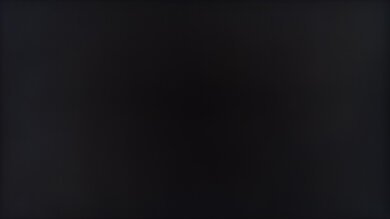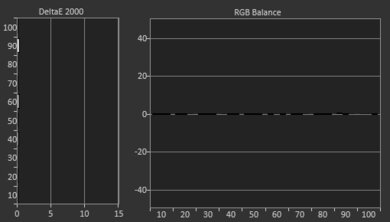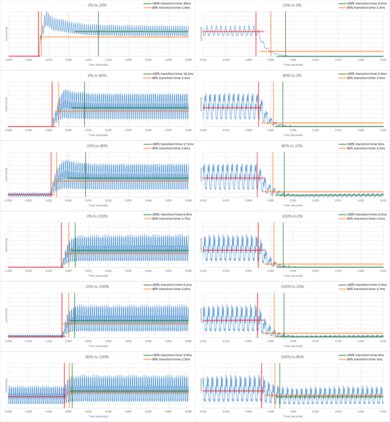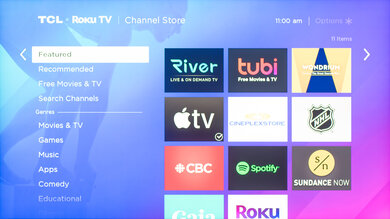The TCL R745 QLED is a great 4k TV that's only available in an 85 inch model. It's the mid-range model in TCL's XL lineup that they released in 2021 and only has three TVs. The larger size provides a bigger option compared to TCL's past models. It performs well in dark environments because it has a VA panel with a high contrast ratio to display deep blacks, but even though it has a full-array local dimming feature, it's mediocre and causes blooming around bright objects. If you want to use it in a well-lit room, it gets bright enough to combat glare, but its reflection handling is just decent. It has a few extra gaming features like variable refresh rate (VRR) support, a quick response time, and relatively low input lag, but it lacks HDMI 2.1 inputs, so it's not future-proof for gaming with the PS5 or Xbox Series X.
Our Verdict
The TCL 85R745 is great for most uses. It's great for watching movies in dark rooms because it has a VA panel that produces deep blacks, but its local dimming feature is mediocre and causes a ton of blooming. It's good for watching sports or shows in bright rooms because it has fantastic peak brightness, but its reflection handling is just decent, and it has narrow viewing angles. It's great for gaming, either in SDR or HDR, because it has a quick response time, low input lag, and variable refresh rate (VRR) support, and it gets bright enough to make highlights pop in HDR.
- VA panel with high native contrast.
- High real scene peak brightness in SDR and HDR.
- Excellent response time.
- 120Hz panel with VRR support.
- Mediocre local dimming feature causes blooming.
- Narrow viewing angles.
- No HDMI 2.1 inputs.
The TCL 85R745 is great for watching movies in dark rooms. It has a VA panel with a high native contrast ratio to display deep blacks. It has a full-array local dimming feature that improves the contrast, but it's mediocre overall and causes too much blooming around bright objects. On the plus side, the TV removes 24p judder from any source and doesn't have any upscaling issues.
- VA panel with high native contrast.
- No trouble upscaling lower-resolution content.
- Removes 24p judder from any content.
- Mediocre local dimming feature causes blooming.
The TCL 85R745 is good for watching TV shows in bright rooms. It has fantastic peak brightness, and even though its reflection handling is just decent, visibility shouldn't be an issue. It doesn't have any trouble upscaling lower-resolution content, and the Roku TV platform has many streaming services available to download. Unfortunately, it has narrow viewing angles, so it's not an ideal choice for wide seating arrangements.
- No trouble upscaling lower-resolution content.
- High real scene peak brightness in SDR and HDR.
- Narrow viewing angles.
- Reflection handling is just decent.
The TCL 85R745 is good for watching sports in a well-lit environment. Visibility shouldn't be an issue as it gets bright enough to combat glare, but it gets less bright with larger areas of uniform color, like on a hockey rink. Motion looks good as it has an excellent response time, but you may notice black smearing with darker objects. Sadly, it has narrow viewing angles, so the image looks inaccurate from the sides.
- No trouble upscaling lower-resolution content.
- High real scene peak brightness in SDR and HDR.
- Excellent response time.
- Narrow viewing angles.
- Less bright with large areas of uniform color, like in sports or web pages.
The TCL 85R745 is great for gaming. It has a 120Hz panel and an excellent response time for smooth motion, but you may notice black smearing in dark scenes. Input lag is higher than the competition, but it's still low overall. It even has VRR support to reduce screen tearing, but with HDMI 2.0 inputs, 4k gaming is limited to 60Hz. Lastly, it has a VA panel with a high contrast ratio if you want to game in the dark, but the local dimming feature is mediocre.
- VA panel with high native contrast.
- Excellent response time.
- 120Hz panel with VRR support.
- Objectively low input lag.
- Mediocre local dimming feature causes blooming.
- Some black smearing with darker transitions.
- No HDMI 2.1 inputs.
The TCL 85R745 is great for watching HDR movies. It has impressive dark room performance thanks to the high native contrast ratio and the local dimming feature that improves it. However, the local dimming causes too much blooming around bright objects, and it can be distracting. The TV displays a wide color gamut for HDR content, and it gets bright enough to make highlights stand out.
- VA panel with high native contrast.
- High real scene peak brightness in SDR and HDR.
- Displays wide color gamut.
- Mediocre local dimming feature causes blooming.
The TCL 85R745 is great for HDR gaming. It has great gaming features like a 120Hz panel and VRR support. It also has an excellent response time and low input lag for a smooth and responsive gaming experience. HDR content looks great because it displays deep blacks, has a wide color gamut, and gets very bright in HDR. Sadly, the local dimming feature is mediocre and causes too much blooming around bright objects.
- VA panel with high native contrast.
- High real scene peak brightness in SDR and HDR.
- Excellent response time.
- 120Hz panel with VRR support.
- Mediocre local dimming feature causes blooming.
- Some black smearing with darker transitions.
- No HDMI 2.1 inputs.
The TCL 85R745 is great to use as a PC monitor. It performs well in bright spaces as it has decent reflection handling and fantastic overall peak brightness, but large areas, like on a webpage, are dimmer. It displays proper chroma 4:4:4, but due to its large size, pixel density is low, and you'll need to increase the scaling. Also, it has narrow viewing angles, so the edges of the screen will appear darker if you sit too close.
- High real scene peak brightness in SDR and HDR.
- Excellent response time.
- 120Hz panel with VRR support.
- Objectively low input lag.
- Narrow viewing angles.
- Reflection handling is just decent.
- Less bright with large areas of uniform color, like in sports or web pages.
Changelog
- Updated Sep 26, 2025: We uploaded the latest brightness measurements and uniformity photos for the Accelerated Longevity Test.
- Updated Jul 08, 2025: We uploaded the latest brightness measurements and uniformity photos for the Accelerated Longevity Test.
- Updated Apr 17, 2025: We uploaded the latest brightness measurements and uniformity photos for the Accelerated Longevity Test.
- Updated Feb 11, 2025: We uploaded the latest brightness measurements and uniformity photos for the Accelerated Longevity Test.
Check Price
Differences Between Sizes And Variants
We tested the 85 inch TCL R745 (85R745), the only size available for this model. It's part of TCL's XL lineup, which features three 85 inch TVs, including the entry-level TCL 4 Series, this one, and a yet-to-be-released 8k Mini LED TV.
If someone comes across a different type of panel or if their TCL 85R745 doesn't correspond to our review, let us know and we will update the review. Note that some tests, like gray uniformity, may vary between individual units.
Our unit was manufactured in May 2021. There are two labels on this unit. You can see the main label here and the manufacturing date here.
Popular TV Comparisons
The TCL 85R745 is a great TV available in a larger size, and it provides good value for its price. Picture quality is impressive thanks to the high contrast and fantastic peak brightness, but its local dimming feature is mediocre. It's a good choice if you want it for streaming content, but it's not future-proof for gaming as it lacks HDMI 2.1 inputs, which is disappointing for a higher-end 4k TV in 2021.
Also see our recommendations for the best 80-82-85 inch TVs, the best 4k TVs, and the best Roku TVs.
The LG C1 OLED and the TCL R745 QLED use different panel technologies, each with pros and cons. The LG has an OLED panel with a near-infinite contrast ratio, perfect black uniformity, and wide viewing angles. It also has HDMI 2.1 inputs, while the TCL is limited to HDMI 2.0, so you can only play 4k @ 120fps games on the LG. On the other hand, the TCL is an LED TV only available in an 85 inch size. It gets much brighter than the LG, so highlights pop more, and it has much better out-of-the-box accuracy, but this can vary between units. LED TVs like the TCL also don't suffer from the risk of permanent burn-in like OLEDs.
The Sony X90J and the TCL R745 QLED are two great TVs with a few differences. The Sony is available in several sizes, from 50 to 75 inches, but the TCL is only available in an 85 inch size. They each have a local dimming feature, but the one on the Sony is more effective. The TCL gets brighter and displays a wider color gamut for HDR, but the Sony has better gradient handling. The TCL is limited to HDMI 2.0 bandwidth while the Sony has HDMI 2.1 inputs for high-frame-rate gaming.
The TCL R635 and the TCL R745 QLED are both very good TVs. While the R635 is available in 55- to 75-inch sizes, the R745 is only available in an 85-inch model. They're similar overall, but the R745 is slightly better in a few areas, such as HDR peak brightness, gradient handling, and response time. However, the R635 has much better speakers, so sound is better without needing a receiver.
The Hisense U8G is better overall than the TCL R745 QLED. They each have a VA panel with high contrast, but the Hisense has a much better local dimming feature that helps it produce deeper blacks. The Hisense has more gaming features like HDMI 2.1 inputs, while the TCL is limited to HDMI 2.0. Even though the TCL gets brighter, the Hisense is a better choice for well-lit rooms because it has much better reflection handling. Lastly, the Hisense is available in 55 and 65 inch sizes, but the TCL is available in a larger 85 inch size.

We buy and test dozens of TVs yearly, taking an objective, data-driven approach to deliver results you can trust. Our testing process is complex, with hundreds of individual tests that take over a week to complete. Most of our tests are done with specially designed test patterns that mimic real content, but we also use the same sources you have at home to ensure our results match the real-world experience. We use two main tools for our testing: a Colorimetry Research CR-100 colorimeter and a CR-250 spectroradiometer.
Test Results

The TCL 85R745 looks similar to the TCL 6 Series/R635 2020 QLED, but it has a different stand. It's mainly made of plastic, but there's some metal on the frame around the bezels. It has a fairly premium style, but the stand takes up a lot of space if you need to use a table.
The stand is as wide as the TV itself and the feet are deep too, so you'll need a very large table to place it on. The stand raises the TV 3.9 inches off the table, and there are 4.8 inches to the bottom of the screen, so there's enough space to place a soundbar without blocking your view. You can't adjust the height of the feet.
Footprint of the 85 inch TV: 75.3" x 16.1".
The back of the TCL 85R745 is a mix of glossy plastic on top and cheap-feeling matte plastic at the bottom. The circle on the left side of the VESA mount is the subwoofer. Unfortunately, there's no cable management.
The TCL 85R745 has decent build quality. The metal stand holds the TV very well, and there's minimal wobble, which is great considering its size. The edges are metal but the rest of the TV is plastic. There's minimal flex on the back, but the plastic at the bottom feels cheap. Our unit came damaged on the back, and it shows how cheap the plastic is on the back, so we considered it for the overall build quality.
The TCL R745 has fantastic SDR peak brightness. It easily gets bright enough to fight glare even in the brightest of rooms. Brightness varies a bit between scenes, and it's especially noticeable with larger areas of bright colors, as seen in the dip in brightness with the 100% window. This can be an issue when watching sports, like a hockey or basketball game.
We tested the brightness after calibration in the 'Movie' Picture Mode with TV Brightness set to 'Brighter', Local Contrast to 'High', Color Temperature to 'Warm' and Backlight and Contrast at their max.
If you want an even brighter image and don't care image image accuracy, use the same settings but set the Picture Mode and Color Temperature to 'Normal'. We reached 1883 nits in the 25% peak window with these settings.
The TCL 85R745 has a mediocre local dimming full-array local dimming feature. There are 192 zones, but they're not very effective. The local dimming can get distracting as there's too much blooming around bright objects. It's similar behavior to what we saw with the Samsung QN800A 8k QLED, but the blooming isn't as strong. Because of this blooming, subtitles are distracting and can even bleed into the black bars at the bottom in some movies.
There's a ton of black crush to the point where you lose details in the background in some scenes, but then there are other scenes, like the star field in Our Planet, that the crush isn't as bad. Fast-moving objects transition between zones fairly well, but there's a small trail behind fast-moving objects, and there's also the golf ball effect visible on the circles in our local dimming video, similar to the TCL 8 Series 2019/Q825 QLED.
The local dimming feature performs the same in Game Mode as outside of it; it's mediocre.
The TCL R745 has incredible HDR brightness. Real content is brighter than in SDR, but the test windows are only a bit brighter. Even though small highlights are slightly dimmer than the rest due to the local dimming, it still makes highlights really stand out. Sadly, large areas are once again dim due to the aggressive Automatic Brightness Limiter (ABL). The EOTF follows the target fairly well, but darker scenes are slightly too dark.
We tested the HDR brightness in the 'Dark HDR' Picture Mode with Local Contrast on 'High', TV Brightness on 'Brighter', and Backlight and Contrast each at '100'. These settings result in the brightest EOTF, but we were able to reach 1921 nits in the 25% window by setting the Picture Mode to 'Normal HDR' and Color Temperature to 'Normal'. However, this results in a less accurate image.
The HDR brightness in Game Mode is incredible, and it's extremely similar to it outside of Game Mode. The test slides are slightly less bright, but it's hardly noticeable with real content. We tested it with the same settings as outside of Game Mode.
The TCL 85R745 has decent gray uniformity, but this can vary between units. The edges are darker, and there's a bit of dirty screen effect in the center, but it's not too bad. Sadly, there's noticeable backlight bleed in near-dark scenes, which could get distracting.
The black uniformity is good. Without local dimming, the screen is more uniform, but there's some clouding, and blacks look closer to gray. Uniformity scores worse with the local dimming feature enabled, but that's because there's more blooming around the center cross. The local dimming does a good job at improving the black level, though.
The TCL 85R745 has narrow viewing angles, which is expected from a VA panel. The image loses accuracy and brightness as you move off-center, so it's not ideal for wide seating arrangements. Due to the size, the edges of the screen will appear darker if you sit too close. If good viewing angles are important to you, the LG QNED90 is a much better TV for a wide seating area.
The TCL 85R745's reflection handling is decent. It has a semi-gloss finish that does a fairly good job at handling a moderate amount of light, but it's not so good if it's opposite a bright window. The reflections photos look a bit different than most 55 and 65 inch TVs we've tested because this screen is so much larger, and various objects in the testing room are visible.
The TCL R745 has great out-of-the-box accuracy. Most colors are only a bit inaccurate, but white balance is slightly off. Color temperature is extremely close to our 6500K target. Sadly, gamma doesn't follow the 2.2 target at all as all scenes are too bright. Keep in mind that accuracy can vary between units.
The TCL R745 has fantastic accuracy after calibration. White balance is significantly improved, and colors are a bit better, too. Both the color temperature and gamma are spot on with our targets, which is outstanding.
See our recommended settings here. All calibration is done through the Roku app and not directly on the TV.
The TCL R745 uses a BGR subpixel layout, which can affect how text is displayed when using the TV as a PC monitor, but it doesn't affect the picture quality. You can read about it here.
The TCL R745 displays an excellent color gamut for HDR content. It has outstanding coverage of the DCI P3 color space used by most HDR content, and its coverage of the wider but less common, Rec. 2020 color space is also very good.
The color volume is good. Thanks to the wide color gamut, excellent contrast, and high peak brightness, it displays colors at a wide range of luminance levels.
The TCL 85R745 has good gradient handling. It's much better than the TCL 6 Series/R635 2020 QLED, but it's still worse than many 4k TVs we've tested. Banding is noticeable with most colors, especially with grays and greens. This can be distracting in scenes with different shades, like sunsets. Sadly, the Noise Reduction setting doesn't improve the gradient handling.
We don't expect VA panels to experience permanent image retention, as the VA panel in our long-term test appears immune.
The TCL 85R745 has an excellent response time. Motion looks smooth for the most part, but there's some blur trail behind fast-moving objects. Also, it has a slower response time with dark transitions, which is the cause of black smearing and is typical of VA panels.
There's an optional black frame insertion feature to try to reduce persistence blur. It improves motion but also causes more ghosting. It can only flicker at 60Hz and not 120Hz, so it's not useful for 120fps games. Our BFI score is based on the available flicker frequencies and not the actual performance.
The TCL 85R745 has a motion interpolation feature to bring lower-frame rate content up to 120fps. However, it doesn't perform that well in busy scenes and creates noticeable artifacts and halos around characters' heads, which is very distracting.
Since the response time is so quick, lower-frame rate content can appear to stutter as each frame is held on longer.
The TCL R745 automatically removes 24p judder from any source. This helps with the appearance of motion in movies.
The TCL R745 supports variable refresh rate (VRR) technology to reduce screen tearing. It has native FreeSync support and is G-SYNC compatible for those with NVIDIA graphics cards. We can't confirm if it supports HDMI Forum VRR because the Xbox Series X supports both FreeSync and HDMI Forum VRR, and we don't know which one is working. Since the TV is limited to HDMI 2.0, 4k VRR only works within a narrow refresh rate range.
The input lag is very low. It's slightly higher than other 2021 TVs, but it's still low enough for gaming, and you shouldn't notice any delay. Unfortunately, you shouldn't use the motion interpolation feature in Game Mode as it dramatically increases the input lag. We couldn't properly measure the input lag with VRR enabled as it's likely an issue with our testing methodologies, and we experienced the same issue with the Samsung QN90A QLED. We'll update the review once we fix it, and that said, we don't expect the input lag to increase with VRR enabled.
The TCL R745 supports all common resolutions under the HDMI 2.0 bandwidth, up to 4k @ 60Hz. It displays 1440p @ 120Hz signals natively, but strangely you need to create a custom resolution on your PC for 1440p @ 60Hz signals. It displays proper chroma 4:4:4 on any supported resolution, which helps with text clarity when using it as a PC.
The TCL 85R745 displays any signal from the PS5 and Xbox Series X at 4k @ 60Hz or below. It has an Auto Low Latency Mode that automatically switches the TV into Game Mode when you launch a game from a compatible device, and there aren't any settings for it. You can also see that the TV supports both HDR10 and Dolby Vision from the Xbox here.
The TCL R745 is limited to HDMI 2.0, but if you want a large TV with HDMI 2.1 inputs, look into the Sony X91J.
The TCL R745 has eARC support, allowing you to pass Dolby Atmos via True HD signals to a compatible receiver through a signal HDMI connection. However, the DTS:X via DTS-HD MA audio format doesn't seem to work because our receiver didn't play the DTS:X file as it only played DTS. We don't know if this is a glitch with the TV or if it's designed this way. Let us know if you have this TV and if DTS-X works.
The frequency response is decent. Despite having a subwoofer on the back, it doesn't provide any punch to the bass. Above the low-frequency extension, it has a fairly well-balanced sound profile, so dialogue sounds good, and it gets really loud.
The TCL 85R745 has okay distortion performance. There's hardly any distortion at moderate listening levels, but it's a lot more noticeable at its max volume. However, this depends on the content, and not everyone may hear it.
The Roku TV interface is great as it's user-friendly, and menu navigation feels very smooth. It automatically had an Olympic theme at the time of testing, which is why it's different from the TCL 6/R635 2020 QLED, but you can change the theme in the settings.
The TCL R745 comes with the same Roku remote as other TCL TVs. It's small and has a few shortcut buttons to popular streaming devices. It has a built-in mic for voice control, and you can ask it to change inputs, open apps, and search for content, but you can't ask it to change specific settings.





















































